‘Behemoth’ is a word which springs to mind or, perhaps more nautically, ‘leviathan’.
- Capable performer for its size
- Performs with outboards from 40hp to 90hp
- Slightly old school interior provides practical boating solutions.
- Boat easy to up-spec
Veteran Melbourne boat manufacturer International Marine’s smallest offering, the unassuming 5.5m Caribbean Offshore, performs far better than its modest size would suggest.
Offering a dry ride, decent freeboard and good stability at rest, the Offshore is a small fibreglass cuddy-cabin family/fishing boat that’s easily towed, easily driven and robust enough to handle moderately rough water.
This boat was designed as a practical, rugged 16-foot fishing platform. All up the boat is 5.5m long, including the bowsprit and swim platforms – this is the first 5.5 Offshore in New Zealand.
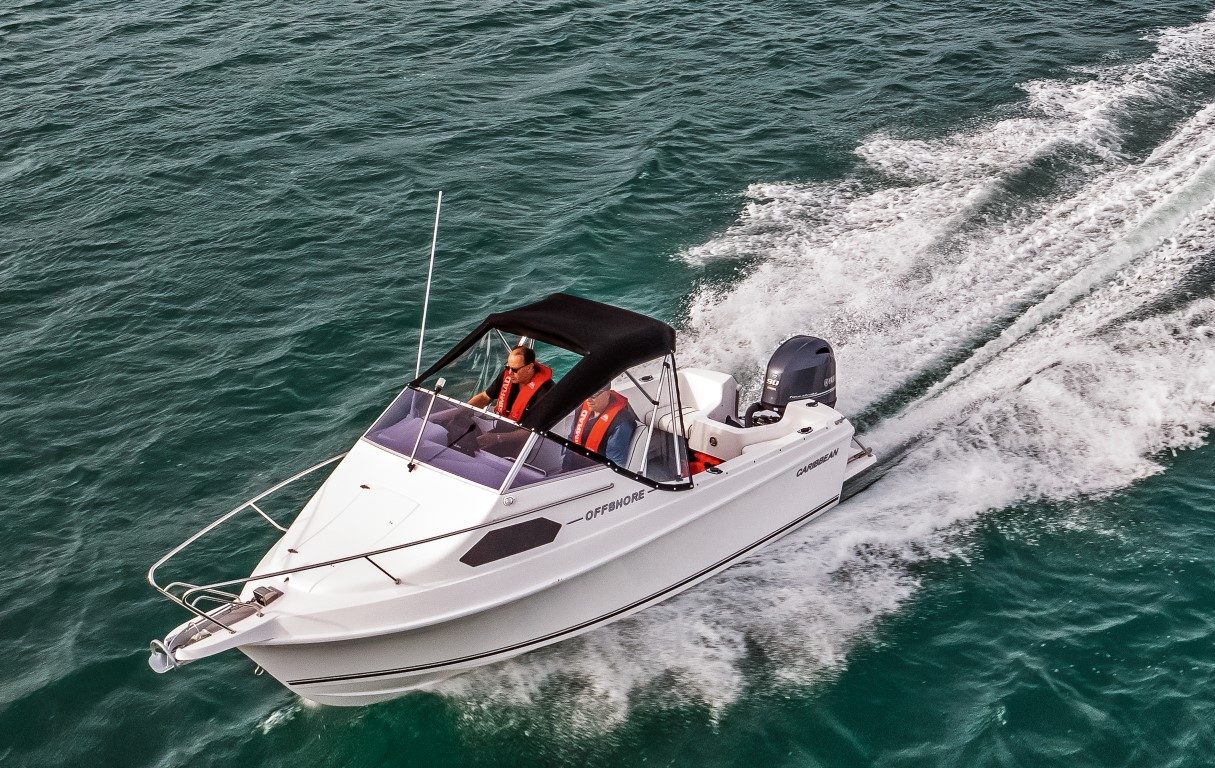
In standard trim the 5.5m Offshore is fairly basic, but Scott White, whose family has marketed Caribbean boats in New Zealand for over 10 years, ticked all the factory options on this boat.
These include LED navigation and cabin lights, a canopy, tonneau cover, removable carpet, port-side swim platform and boarding ladder, bilge pump, removable rear seats and a cabin-top grab-rail. White also specified a second swim platform for the starboard side and upgraded from mechanical to hydraulic steering.
Once the boat arrived in New Zealand, Scott doubled down on the upgrades, fitting a top-of-the-range Yamaha 90hp four-stroke outboard, high-end Simrad electronics, Perko moulded plastic rod holders, a removable Perko bait board, plus a Maxwell drum winch with 110m of chain and rode.

The baby Caribbean is carried on a single axle Australian-built Easy-Tow trailer mechanically braked with cable brake activation, in keeping with Australian trailer regulations. With a dry tow weight of 1,026kg it doesn’t need a braked trailer here in New Zealand, but brakes are a bonus, giving peace of mind when towing the rig with a smaller vehicle.
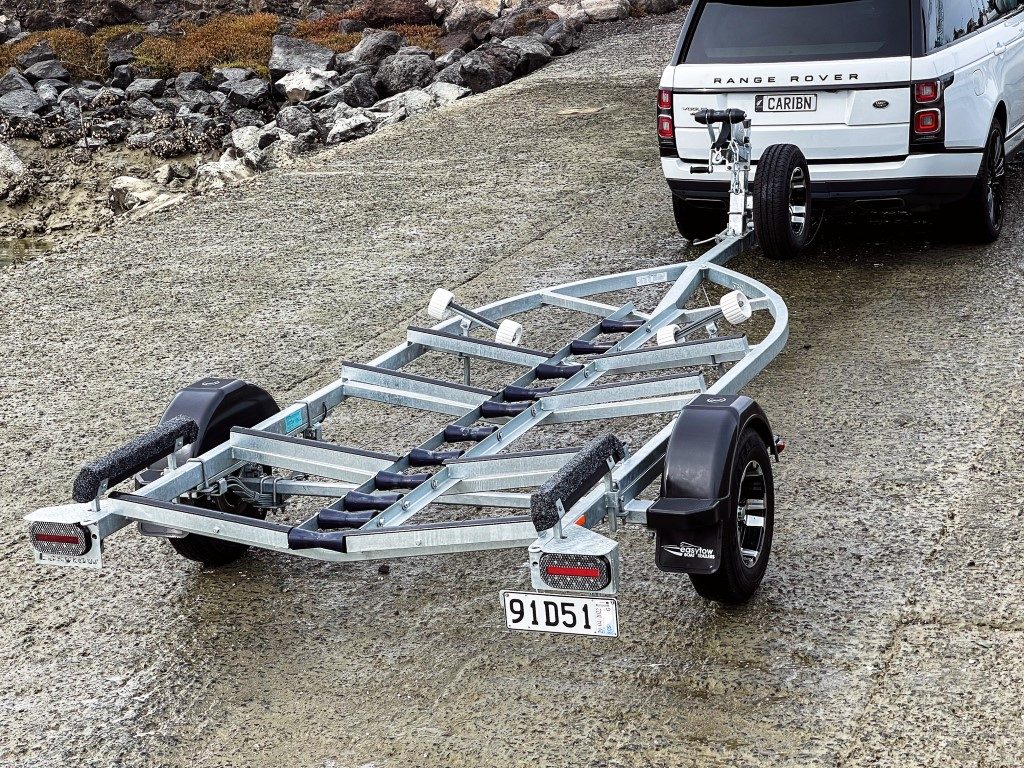
In many respects this is an old school trailer boat. The fuel is carried in tote tanks (two) in a bay amidships under the outboard well, flanked by isolation switches and twin batteries in boxes on the floor under the rear seats. Scott decided to fit twin batteries to accommodate the electronics and drum winch.
In small boats like this, tote tanks are perfectly sensible. They’re easy to remove at filling time and easier to deal with than in an underfloor tank should any water contaminate the fuel. The moulded bay stops the tote tanks sliding around the cockpit.
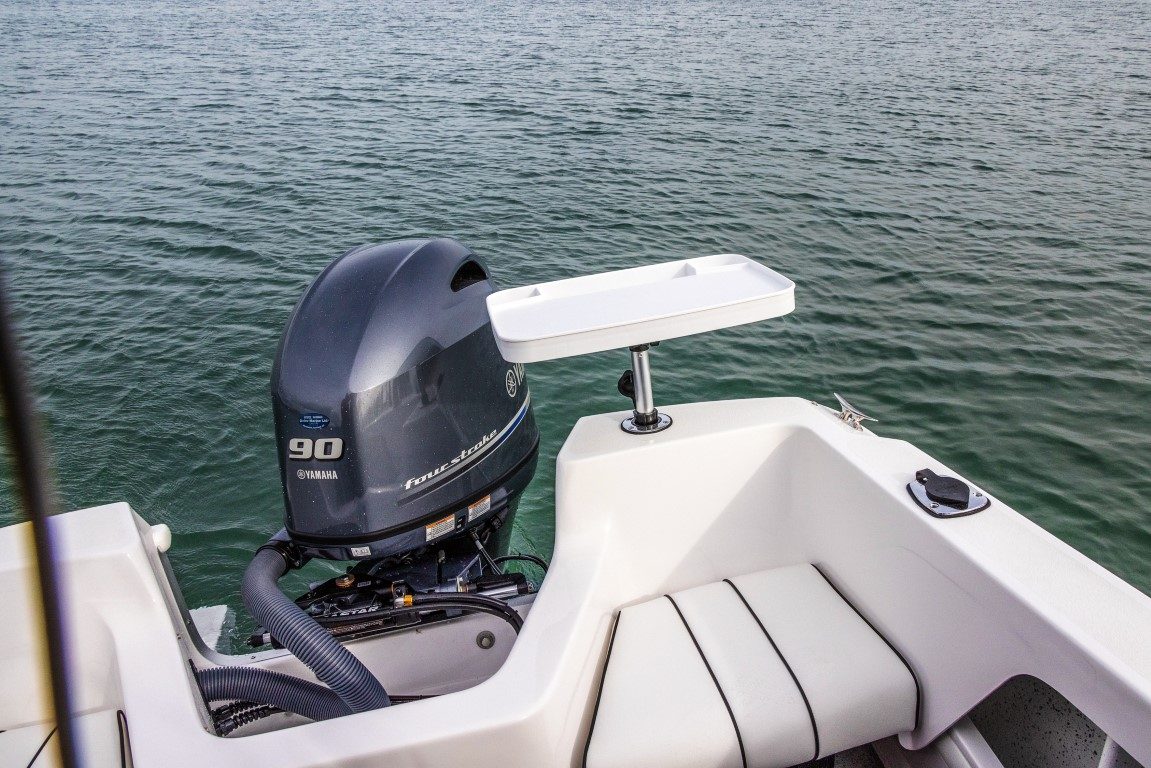
The cockpit is a decent size for a small boat. A removable carpet offers secure footing but it’s easy to take out when messy activities– scallop dredging, for instance – are planned, or to facilitate thorough washing. No washdown was fitted, but a bucket is perfectly serviceable in a small boat. The cockpit drains to the sump aft, serviced by a bilge pump on a float switch.
This boat doesn’t have a full GRP liner, so there is plenty of flow coat on display. The cabin isn’t lined, so flow coat dominates there too, but vinyl upholstered shelf panels and fabric covered v-berths soften the interior somewhat. Padded, vinyl-covered side panels also face the cockpit shelves, which are raised off the cockpit sole to provide toe room.
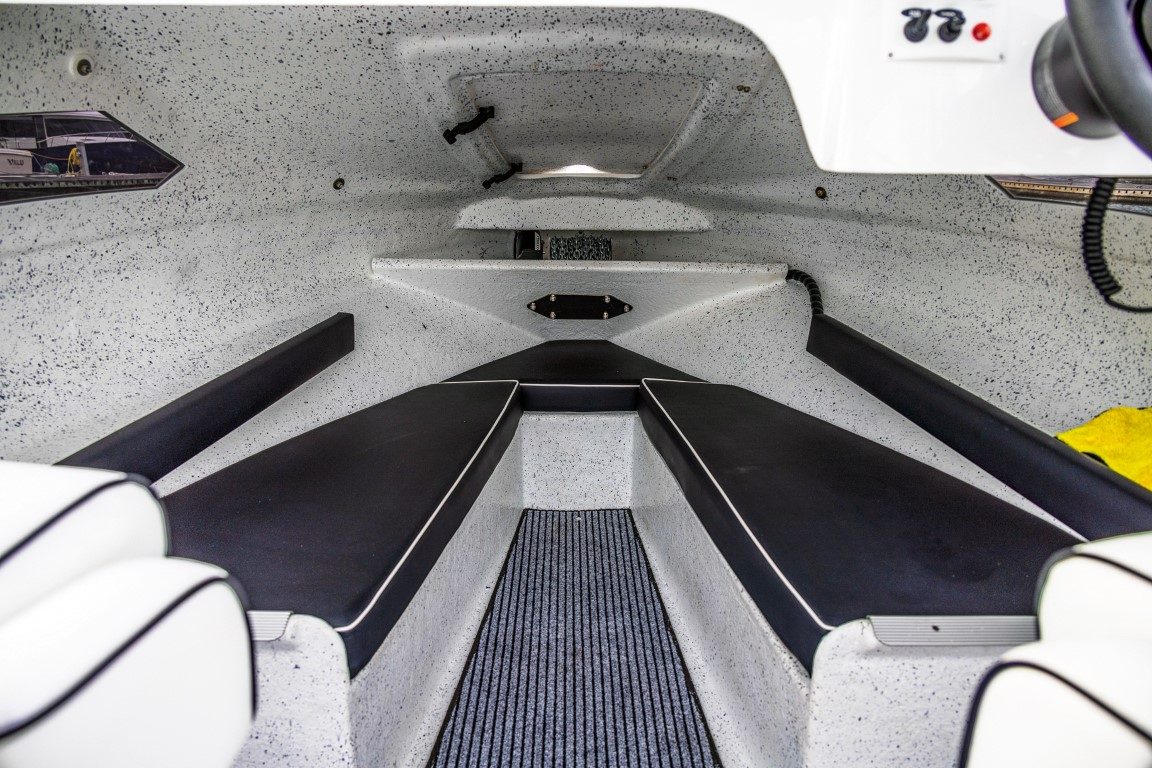
Two angled through-coaming rod holders per side, plus one on the transom for the bait table, are non-standard features. With a folding canopy, there’s no provision for extra rod storage in a rocket launcher, but there’s some storage in the side pockets for longer items with standard rod racks under the gunwales, but no storage lockers. A chilly bin, perhaps with a padded lid as an extra seat, would be the sensible storage solution for bait, ice and the catch. Again, this is a basic 16-foot boat.
A pair of smart upholstered Hi-Tech seats tucked up under the folding canvas canopy swivel on aluminium pedestals. The seats can be adjusted for height and reach, the passenger gets a stainless steel grabrail and alloy-capped footrests are moulded into the low cabin bulkhead. A zipped centre section of the canopy rolls up for better visibility – or leave the canopy at home in good weather.
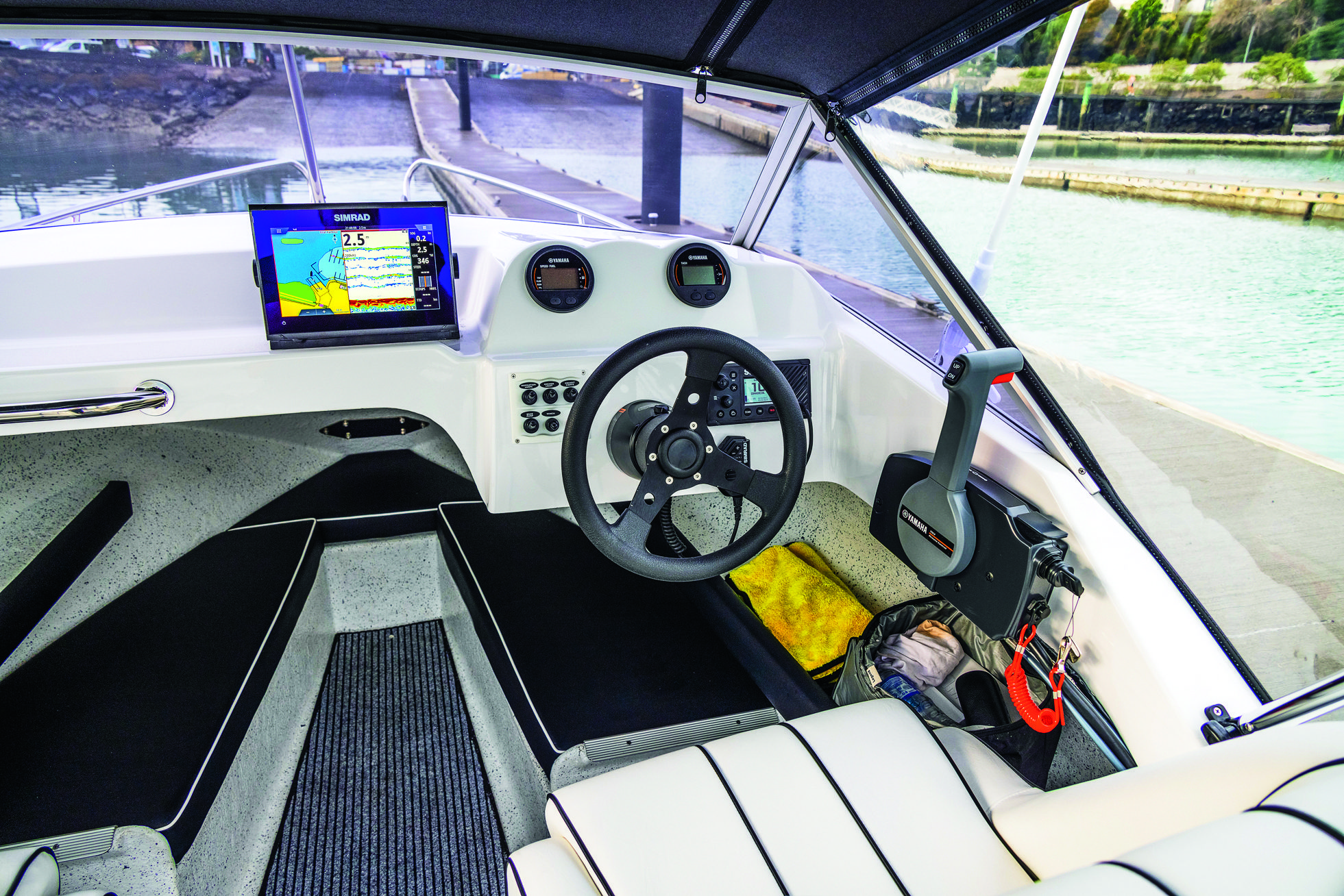
The seats offer reasonable comfort and support, including laterally, and the helm position is good with reasonable seated vision through the aluminium-framed acrylic windscreen – to stand and drive the canopy must rolled up. There’s not a lot of space on the moulded helm console but enough for the Yamaha instruments, a switch panel and the Simrad RS205 VHF radio – the Simrad GO9 nine-inch display is bracket-mounted on the dashboard.
The cabin is modest, the short-ish v-berths best utilised as seats, but there is useful storage under the squabs and a good-sized fibreglass hatch for stand-up access to the bow. The two-compartment anchor locker is a moulded, angled shelf accessed through the cabin from inside or via the locker hatch from the outside. The shelf has been modified to accept a drum winch, which is operated from the helm with the CQR anchor mounted permanently on the bowsprit.

The weather on the morning of our review was unsettled with rain and sun chasing each other across the skies and a stiff north-easterly breeze stirring up steep seas in the channels between the islands. Nonetheless, we decided to brave portions of the Rangitoto and Motuihe channels for the promise of relatively sheltered water in the lee of Motuihe Island, which we wanted for the photos.
On the way out, punching into the waves, the little Caribbean performed admirably, delivering a surprisingly dry and comfortable ride. We managed most of the journey with the boat comfortably on the plane. Planing speed is around 13-14 knots.
The 90hp Yamaha is at the top of the horsepower range for this vessel, which performs acceptably with as little as 40hp. The extra power was welcome in the conditions, the relatively large propeller allowing us to hold the plane at lower speeds.

In the flat water we could give the Yamaha its head, achieving a top speed close to 40 knots. In reasonable conditions this Caribbean 5.5m can cruise in excess of 30 knots and offers comfort and economy anywhere between 25 and 30 knots. At trolling speed, 7 knots, fuel consumption is just 7lph.
With hydraulic steering the rig feels very responsive, the boat going where it’s pointed and feeling nicely balanced. It’s fun to throw around, heeling over in turns, but not too far, thanks to the spray rails/chines. Hole shots are almost instantaneous.
Moulded strakes provide the hull with some extra lift, which is useful since the entry is reasonably fine and the helm position well forward. Deadrise aft is a modest 15° which, along with the chines, ensures the boat is pleasingly stable at rest.
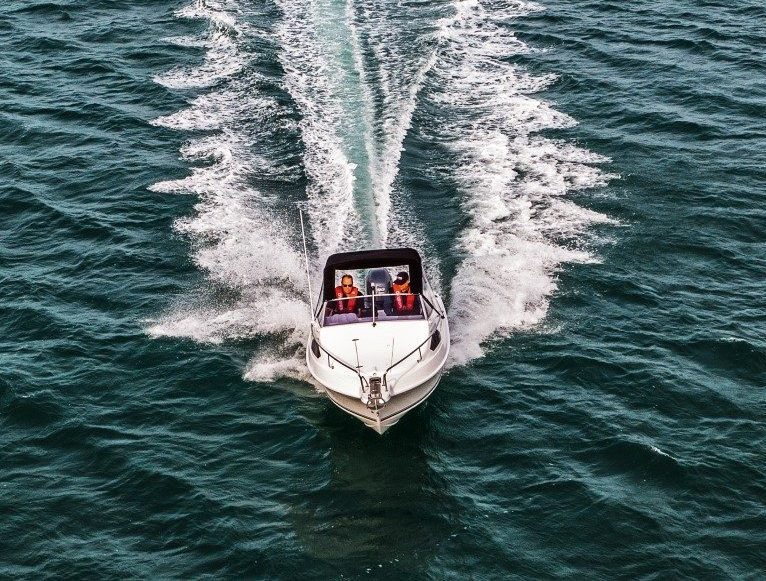
On the way back to the boat ramp we had the wind behind us, but the seas were still steep and with the strengthening wind, if anything, bigger than before. The boat’s ride, however, was even better – and I’d been impressed punching into the seas on the way over – which perhaps lulled us into a certain degree of complacency.
We were reminded that the Offshore is only 5.5m long when we stuffed it into the back of an especially steep wave at 18 knots, sending a sheet of water over the windscreen and into the cockpit. The bilge pump quickly dealt with the deluge, but we sheepishly dialled the speed back a few knots (and trimmed up the bow).
While the boat’s occupants were a tad wet, the smallest Caribbean subsequently delivered a dry, comfortable ride the rest of the way home, suggesting the ‘Offshore’ label is not just for show.
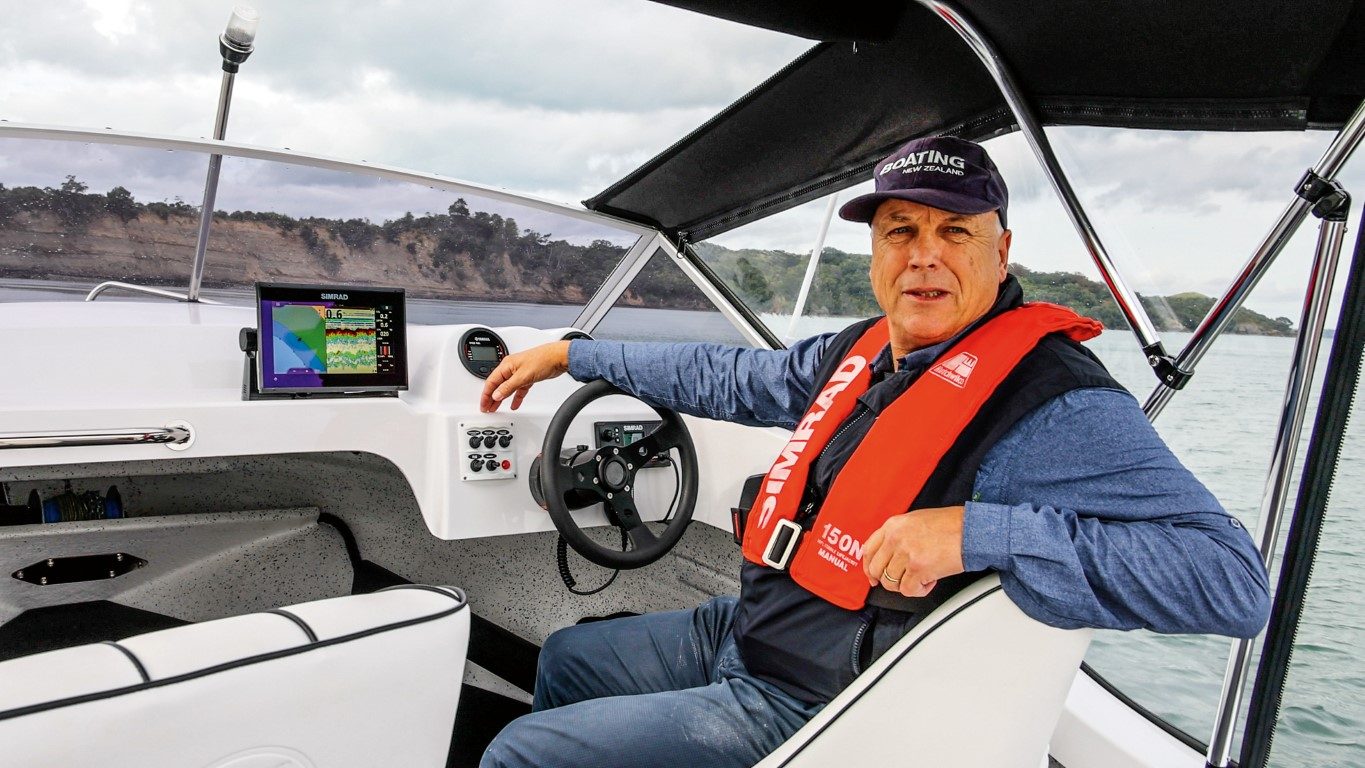
The Caribbean 5.5m Offshore is a practical, slightly old-school 16-footer that provides no-frills boating at a reasonable price. And you can add options and equipment for a more upscale boating experience, depending on your budget.
Easily towed, easily driven and with a capable, soft riding hull, for a small boat it delivers good performance in the rough, a decent turn of speed and stability at rest. It’s an honest fishing boat that can easily fulfil family boating duties as well.
‘Behemoth’ is a word which springs to mind or, perhaps more nautically, ‘leviathan’.
White Pointer has earned the respect of discerning customers in New Zealand and Australia, attracting a loyal and ever growing following for its high-quality, rugged and totally dependable aluminium trailer boats.
The hardtop SP635 shares the same underpinnings as the popular SF 635 which was a completely new model back in 2020.
The pride and joy of a multi-generational family, Bliss resides on a pier that’s home to a couple of other Elite motor launches – Sandspit Marina is a hot-spot for the Bill Upfold-designed vessels, with several calling this small marina home.